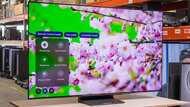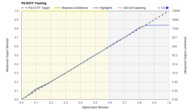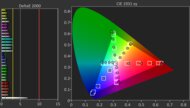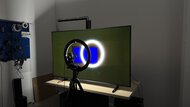Samsung releases a fair share of new models every year, so if you find yourself searching the internet for the best Samsung televisions, you might become overwhelmed by the number of options. We buy and test dozens of TVs each year, and we've reviewed over 140 Samsung TVs, so we can help narrow down your options to find the best Samsung television for your needs and budget.
Generally speaking, Samsung TVs are versatile and can provide good-to-excellent picture quality. Samsung introduced their new Neo QLED TV lineup in 2021, which is an improvement on their more traditional QLED lineup as it introduces Mini LED backlighting. When combined with the quantum dot layer, their high-end TVs provide great picture quality. Along with Sony, they also released the first QD-OLED TV in 2022 to compete with LG's OLED lineup, which improves color vibrancy over traditional WOLED panels. Samsung has continued to improve this QD-OLED technology over the past few years, and their high-end OLEDs are still equipped with QD-OLED panels.
You can vote on which Samsung TVs you want us to buy and test, check out our 2025 TV lineup page, and learn about Samsung's Tizen OS.
Updates
- 11/25/2025Samsung 100QN80F reviewed
- 10/31/2025Samsung Q8F 2025 reviewed
- 09/24/2025Samsung DU8000 updated
- 09/24/2025Samsung QN95D updated
- 09/24/2025Samsung Q70D updated
Quick Look






We buy and test dozens of TVs yearly, taking an objective, data-driven approach to deliver results you can trust. Our testing process is complex, with hundreds of individual tests that take over a week to complete. Most of our tests are done with specially designed test patterns that mimic real content, but we also use the same sources you have at home to ensure our results match the real-world experience. We use two main tools for our testing: a Colorimetry Research CR-100 colorimeter and a CR-250 spectroradiometer.
-
Best Samsung TV
 Mixed Usage8.9Home Theater9.0Bright Room8.8Sports8.8Gaming9.3Brightness8.7Black Level10Color9.1Processing (In Development)8.3Game Mode Responsiveness9.4Resolution4kNative Refresh Rate165HzScreen FinishMatteTypeOLEDSub-TypeQD-OLEDSee all our test resultsDolby VisionNo
Mixed Usage8.9Home Theater9.0Bright Room8.8Sports8.8Gaming9.3Brightness8.7Black Level10Color9.1Processing (In Development)8.3Game Mode Responsiveness9.4Resolution4kNative Refresh Rate165HzScreen FinishMatteTypeOLEDSub-TypeQD-OLEDSee all our test resultsDolby VisionNoThe Samsung S95F OLED is the best Samsung TV. Like any OLED, you get unrivaled black levels, so blacks are deep and inky in a dark room. Since it uses a QD-OLED panel, you also get incredibly bright and vibrant colors that can't be matched by traditional WOLED displays. A lot of OLED models don't fare well in bright rooms, but this TV is the only OLED on the market that features a matte screen coating. Reflections are almost invisible on this TV, so overhead lights and even direct light sources facing the screen are a non-factor. Combined with its amazing peak brightness, visibility isn't an issue at all on this TV. Another positive is that it has a very wide viewing angle, so it's great for group settings. It comes with Samsung's unique Slim One Connect Box, which gives you quick access to the inputs when the TV is wall-mounted and offers versatility for your setup.
The TV is also equipped with a plethora of modern gaming features like four HDMI 2.1 ports, 4k @ 165Hz, and VRR, making it a great option for pairing with modern consoles and gaming PCs. It also has nearly instant pixel transitions, so motion is crisp and clear. In addition to that, it has exceptionally low input lag for a responsive feel. Home theater enthusiasts may be put off by Samsung's lack of Dolby Vision and DTS audio passthrough, but if you can live without those features, the S95F is one of the best TVs on the market.
-
Best Upper Mid-Range Samsung TV
 Mixed Usage8.6Home Theater8.8Bright Room7.6Sports8.1Gaming9.1Brightness8.0Black Level10Color8.8Processing (In Development)8.4Game Mode Responsiveness9.4Resolution4kNative Refresh Rate144HzScreen FinishGlossyTypeOLEDSub-TypeQD-OLEDSee all our test resultsDolby VisionNo
Mixed Usage8.6Home Theater8.8Bright Room7.6Sports8.1Gaming9.1Brightness8.0Black Level10Color8.8Processing (In Development)8.4Game Mode Responsiveness9.4Resolution4kNative Refresh Rate144HzScreen FinishGlossyTypeOLEDSub-TypeQD-OLEDSee all our test resultsDolby VisionNoWhat if you don't need the matte coating, the One Connect box, or 165Hz, and want to spend less? That's where the Samsung S90F OLED comes in, which is the best Samsung TV in the upper mid-range category. Being a QD-OLED, you still get the same perfect black levels and similarly vibrant colors as its older sibling. You also get impressive HDR brightness, so HDR content is impactful. Unfortunately, the TV isn't nearly as bright in SDR as the S95F, and it's not nearly as good with reflection handling due to its glossy coating, so there are some visibility issues in bright rooms. Still, you can watch TV and not be distracted by glare in moderately lit rooms. You also get the same wide viewing angle as the more expensive model, so it's great for wide seating arrangements.
Despite not offering 165Hz support, you can still game in up to 4k @ 144Hz with VRR on any of its four HDMI 2.1 ports. The TV has the same nearly instant pixel transitions and low input lag, so you get a sharp and smooth gaming experience. Like any Samsung TV, it doesn't support Dolby Vision or DTS audio passthrough, but it still offers HDR10+. If you're considering this TV, just keep in mind that only some sizes have a QD-OLED panel, and even that varies by region.
-
Best Mid-Range Samsung TV
 Mixed Usage8.2Home Theater8.4Bright Room7.2Sports7.6Gaming8.6Brightness6.6Black Level10Color8.6Processing (In Development)8.3Game Mode Responsiveness9.1Resolution4kNative Refresh Rate120HzScreen FinishGlossyTypeOLEDSub-TypeQD-OLEDSee all our test resultsDolby VisionNo
Mixed Usage8.2Home Theater8.4Bright Room7.2Sports7.6Gaming8.6Brightness6.6Black Level10Color8.6Processing (In Development)8.3Game Mode Responsiveness9.1Resolution4kNative Refresh Rate120HzScreen FinishGlossyTypeOLEDSub-TypeQD-OLEDSee all our test resultsDolby VisionNoIf you want an OLED, but the two picks above are out of your price range, consider the Samsung S85F OLED. It's not as bright as the Samsung S90F OLED, and it caps out at 4k @ 120Hz, but outside of that, the two TVs are remarkably similar. You still get the perfect black levels, vivid colors, wide viewing angle, and the nearly instant response times QD-OLEDs are known for. Even though the TV isn't as bright as its more expensive siblings, you can still watch SDR content in a room with a few lights on and not be distracted by reflections. There's a larger disparity in HDR brightness compared to the other two Samsung OLEDs, so highlights in dark scenes and entirely well-lit scenes don't pop out as much, but you still get a decently impactful HDR experience.
Some PC gamers might feel like they're missing out by not having a 144Hz refresh rate, but the TV still offers four HDMI 2.1 ports capable of 4k @ 120Hz with VRR, so the TV is fully compatible with the features offered by modern consoles. Unfortunately, like the S90F, there's a catch. In North America, only the 55-inch and 65-inch models use a QD-OLED panel, whereas the larger options utilize a normal WOLED panel. The rest of the world gets a WOLED panel throughout all size options. You can determine what type of panel it has by looking at the model code.
-
Best Lower Mid-Range Samsung TV
 Mixed Usage7.1Home Theater7.1Bright Room7.6Sports7.7Gaming7.1Brightness7.2Black Level6.9Color7.1Processing (In Development)7.6Game Mode Responsiveness7.7Resolution4kNative Refresh Rate144HzScreen FinishGlossyTypeLEDSub-TypeVASee all our test resultsDolby VisionNo
Mixed Usage7.1Home Theater7.1Bright Room7.6Sports7.7Gaming7.1Brightness7.2Black Level6.9Color7.1Processing (In Development)7.6Game Mode Responsiveness7.7Resolution4kNative Refresh Rate144HzScreen FinishGlossyTypeLEDSub-TypeVASee all our test resultsDolby VisionNoIf you want a Samsung TV, but the QD-OLEDs above are too expensive, the Samsung QN80F is the best lower mid-range Samsung TV. It's a lot brighter than the Samsung S85F OLED in SDR, so it overcomes more glare in a well-lit room. Although the Samsung has local dimming to help deepen blacks, you don't get anything close to the inky blacks you get from OLEDs, and there's haloing around highlights. It has about the same HDR brightness as the S85F, but since its contrast ratio is much lower and it doesn't display as wide a range of colors, HDR content doesn't look as good on it. The TV's viewing angle is pretty narrow, so it's not as good for wide seating arrangements as the OLEDs above.
Fortunately, it has HDMI 2.1 bandwidth, up to 4k @ 144Hz, and VRR, so it pairs excellently with modern gaming consoles. The TV's input lag is low on this model, but pixel response times are a lot slower than they are on OLEDs, so fast motion is a bit blurry. Like almost any Samsung model, it supports HDR10+, which helps HDR content look as good as it can on this model.
-
Best Budget Samsung TV
 Mixed Usage5.8Home Theater5.8Bright Room5.8Sports5.8Gaming5.4Brightness4.9Black Level5.4Color6.4Processing (In Development)6.4Game Mode Responsiveness5.4Resolution4kNative Refresh Rate60HzScreen FinishGlossyTypeLEDSub-TypeVASee all our test resultsDolby VisionNo
Mixed Usage5.8Home Theater5.8Bright Room5.8Sports5.8Gaming5.4Brightness4.9Black Level5.4Color6.4Processing (In Development)6.4Game Mode Responsiveness5.4Resolution4kNative Refresh Rate60HzScreen FinishGlossyTypeLEDSub-TypeVASee all our test resultsDolby VisionNoThe Samsung Q7F 2025 is the best budget Samsung TV available. Samsung doesn't release many budget models anymore, and the ones they do release tend to have mediocre image quality. That's the case here, as the Q7F doesn't have local dimming to help deepen blacks, which leads to dark scenes looking washed out. The TV is also too dim to handle much glare at all in a room with the lights on, so it's best suited for a dimly lit environment. Its lack of brightness also means that HDR content looks underwhelming, since highlights don't stand out like they should. Colors are also more muted on this TV, and the image lacks vibrancy. Like the Samsung QN80F, it has a narrow viewing angle, so it's best viewed from directly in front of the screen.
Unfortunately, this is a 60Hz TV that's pretty bare-bones in terms of gaming features. It doesn't have VRR to reduce screen tearing, and motion is blurry due to its slow pixel response times. However, 4k @ 60Hz gaming has decently low input lag, so at least gaming feels responsive. You still get HDR10+, which makes HDR content look a bit better, but that format doesn't save this TV from looking underwhelming. If you really want a budget Samsung TV, it's not the worst choice, but most people are better off shopping for a budget model from brands like TCL and Hisense.
Compared To Other Brands
-
Well-rounded.Samsung's high-end models are some of the best TVs we've tested. They don't excel in just one category; they're well-rounded and offer great performance for various uses.
-
Perform well in dark and bright environments.Their QLED TVs, especially those with VA panels, have high contrast and get bright, so they're good for dark and bright rooms.
-
Great gaming features.Samsung is a leader in gaming features, and even their mid-range models have variable refresh rate (VRR) and ALLM support.
-
Uniformity issues.Samsung models typically don't have the best gray uniformity and have some dirty screen effect, which could get distracting during sports or PC use.
-
TVs can be costly, and may not offer good value.Samsung's high-end TVs can get costly, so while they provide the best performance, they may not have the best value compared to other brands. There are often cheaper TVs that you can get with no compromises.
-
Few budget models.Although Samsung used to offer a wide range of budget models, in recent years, they've really scaled down their budget lineup. Their budget models typically aren't worth buying when you can get better picture quality and performance from companies like Hisense and TCL.
-
No Dolby Vision or DTS audio support.Although Samsung has their own dynamic HDR format in HDR10+, none of their TVs support the more widely used Dolby Vision format. They also don't include support for advanced DTS audio formats, which are prevalent in physical media.
Samsung vs Sony
Samsung TVs usually have more gaming features than Sony TVs, in particular, lower input lag and official 4k @ 144Hz on some models, and Samsung also has a bigger TV lineup. In comparison, Sony TVs are usually built a bit better, with mostly metal construction. They also tend to have better image processing and color accuracy, so they're better for home entertainment setups, especially as Sony typically supports Dolby Vision HDR and advanced DTS audio formats.
Samsung vs LG
Samsung TVs generally have better picture quality than the average LG LED-backlit TV. Samsung TVs usually get a fair bit brighter and have better contrast, while LG TVs generally have much wider viewing angles and better smart features. While LG was one of the first companies to offer OLED displays and has a few popular models to choose from, Samsung has caught up with their OLED offerings. They offer OLEDs that use the same WOLED panel found in LG's OLEDs, but they also offer QD-OLEDs, which produce brighter and more vibrant colors. LG OLEDs tend to have a bit more features than Samsung's, like support for Dolby Vision HDR. LG also has slightly better image processing than competing Samsung models.
Samsung vs Hisense
Hisense TVs have better value than Samsung TVs, as their TVs tend to be a fraction of the price for equal, and sometimes even better, performance. However, Hisense doesn't have any TVs to compete with Samsung's OLEDs, and their TVs tend to have bugs and quirks that Samsung's products don't have. Plus, Hisense TVs tend to have a narrow viewing angle, so they're not as well-suited for wide seating arrangements.
Samsung vs TCL
TCL TVs are a better value than Samsung TVs, as they offer comparable or better performance for a fraction of the price. Like with Hisense, TCL has no models to compete with Samsung's OLEDs, and their TVs have more bugs and quirks than Samsung's. TCL TVs also have a narrow viewing angle, so they're not optimal for wide seating arrangements.
Samsung TVs provide performance suitable for most buyers, but they can also be costly compared to some competing brands. They generally perform very well and are among the best TVs on the market, especially if you want gaming features. However, competition is increasing, and Samsung LED TVs don't provide as much value as they previously did. On the other hand, their OLED TVs are some of the best on the market and compete with high-end LG OLED models.
2025 Samsung Lineup
Samsung announced their new 2025 lineup at CES in early January 2025, and their full lineup for the year is now available to purchase. Most of their lineup is the same as last year, with a few minor tweaks and improvements across the board. They've doubled down on the controversial matte coating that first appeared on The Frame and made its way to the 2024 S95D, adding it to three of their higher-end LED models.
OLED
Samsung released three new OLEDs in 2025, all of which are new iterations of their 2024 lineup. The entry-level OLED is the Samsung S85F, which replaces the Samsung S85D, but uses a QD-OLED panel on the 55-inch and 65-inch options in North America. This model uses a WOLED panel in all other regions and size options.
In the middle of Samsung's OLED lineup is the Samsung S90F, which is the 2025 version of the popular Samsung S90D OLED. Unfortunately, Samsung is still using both WOLED and QD-OLED panels for the S90F lineup, so the dreaded panel lottery is once again back in 2025, and you could get either panel technology depending on which size you buy and which region you're in.
The Samsung S95F is the replacement for the Samsung S95D OLED and is their flagship model for 2025. Samsung is switching to a 5-layer tandem OLED stack for this model, which increases the overall peak brightness and color volume. However, the 83-inch model uses the same RGB tandem panel as the LG G5 OLED. Like the S95D, this high-end TV utilizes a matte screen coating, but the coating has been upgraded to Glare Free 2.0 for 2025. Another upgrade is the TV's support for 165Hz, up from 144Hz on the 2024 model.
| Model | Sizes | Panel Type | Resolution | Refresh Rate | Notes |
|---|---|---|---|---|---|
| S95F | 55", 65", 77", 83" | QD-OLED (5-stack) on all sizes except the 83" (WOLED) | 4k | 165Hz | Matte coating |
| S90F | 42", 48", 55", 65", 77", 83" | QD-OLED and WOLED | 4k | 144Hz | Panel type depends on the size and region |
| S85F | 55", 65", 77", 83" | QD-OLED and WOLED | 4k | 120Hz | Panel type depends on the size and region |
LED
Samsung is one of the only brands left still releasing 8k models, and that hasn't changed in 2025. Samsung has expanded the usage of their matte screen coating to their two 8k models for 2025. Their entry-level 8k TV, the QN900F, is a Mini LED model with support for up to 120Hz gaming. On the other hand is the Mini LED QN990F, which offers a whopping 8k @ 165Hz and 4k @ 240Hz. Furthermore, the QN990F utilizes Samsung's external One Connect Box, while the QN900F doesn't. Four new 4k Mini LED models have been released—the QN90F, QN80F, QN70F, and The Frame Pro. The QN90F and the Frame Pro use a matte screen coating, whereas the other models use a glossy coating.
Most of Samsung's 4k LED 2025 lineup is very similar to 2024, but The Frame Pro is certainly quite different. This stylish TV has more in common with Samsung's QLED lineup than previous generations of The Frame TV, with a Mini LED backlight and 144Hz refresh rate. As great as that sounds, there's a major catch here. That Mini LED backlight consists of a single strip of LEDs along the bottom edge, making it an edge-lit model. It's very unlikely that this TV will deliver anything close to good local dimming, and our testing has shown that edge-lit TVs don't last as long, so it seems like a strange decision on Samsung's part. There's also Samsung's budget-oriented LED models, but these only have incremental improvements when compared to their 2024 counterparts, so don't expect big changes with those.
| Model | Sizes | Backlight Type | Local Dimming | Resolution | Refresh Rate | Notes |
|---|---|---|---|---|---|---|
| QN990F | 65", 75", 85", 98" | Mini LED | Yes (1,920 zones on the 75") | 8k | 8k @ 165Hz, 4k @ 240Hz | Matte coating, wireless One Connect Box |
| QN900F | 65", 75", 85" | Mini LED | Yes (1,056 zones on the 65") | 8k | 120Hz | Matte coating |
| QN90F | 43", 50", 55", 65", 75", 85", 98", 115" | Mini LED | Yes (900 zones on the 75") | 4k | 165Hz | Matte coating |
| QN80F | 50", 55", 65", 75", 85", 100" | Mini LED | Yes (96 zones on the 65") | 4k | 144Hz | |
| QN70F | 55", 65", 75", 85" | Edge-lit Mini LED | No | 4k | 144Hz | |
| Frame Pro | 65", 75", 85" | Edge-lit Mini LED | Yes (24 zones on the 65") | 4k | 144Hz | Wireless One Connect |
| Q8F | 32", 43", 50", 55", 65", 75", 85" | Edge-lit | No | 4k | 120Hz | |
| Q7F | 43", 50", 55", 65", 75", 85" | Direct-lit LED | No | 4k | 60Hz | |
| Q6F | 75", 85" | Edge-lit | No | 4k | 60Hz |
Product Naming
Samsung's lineup covers everything from budget to high-end models. As a rule of thumb, the higher the number, the better it is, although sometimes the improvements aren't worth it. Samsung releases four main TV lineups, and they use a consistent naming scheme for the top three lineups, which makes it very easy to understand what you're buying simply by looking at the model number.
Samsung uses the prefix 'Q' to denote their mid-range QLED models, and the last letter of these models also reflects the model year. They introduced the Mini LED lineup in 2021, denoted by the prefix 'QN' in the model name, like the Samsung QN90D. Their entry-level models follow a slightly different naming structure in 2025, with a single 'Q' used to identify their lower-end options. For example, the Q7F is a normal LED model without features like local dimming.
Smart Features
In the infancy of smart TVs, Samsung was the leader in functionality and smart features. It isn't to say that they were very good, as it took quite a few years for Smart TV platforms to mature into something comparable to external streaming boxes. However, other companies have caught up to Samsung and offer similar all-around performance, like Roku TV or LG's webOS, meaning the best Samsung smart TV isn't much better than smart TVs from other brands.
Samsung has constantly been updating its Tizen platform to ensure it competes with its competitors. In 2017, they added voice capabilities to their remote and smart platform, making it easier to navigate through menus. In 2018, they added Bixby virtual assistant, so you can use voice to control other Samsung devices in your house, like lights, fridges, and door locks. The 2020 update featured a new, sleeker look with a 'Dark Mode' that isn't as bright as the white theme in older versions, and the 2022 version added a new full-screen webpage, which is an improvement over past versions that had all the apps and settings in a toolbar.
Unfortunately, like any modern smart TV, there's ads shown on the home screen. You can opt out of personalized advertising in the settings, but unfortunately, that only means that you'll see very repetitive, more generalized ads instead of targeted ones.
Interface

The interface is very simple and easy to navigate. Since 2022, Samsung has had a full-screen webpage instead of the toolbar they had in past years. You'll find downloaded apps here, and you can quickly access the different inputs and settings. The interface works well, and there are many animations, but these can be slower on lower-end TVs.
Voice Controls
Samsung overhauled Voice Command in 2017, and voice controls are pretty good now. They updated other smart interfaces in 2018 to search for content and apps and change settings, which is something Samsung has been able to do for a few years. Even more in-depth stuff like calibration settings are only a button press away, which is quite nice.
- Changing inputs
- Launching apps
- Basic online searches, including "What time is it?" or "How's the weather in New York?"
- Changing some settings
It's also possible to search within apps, but only a few apps support this.
Recent Updates
Nov 19, 2025:
Replaced the Samsung Q80D with the Samsung QN80F in the 'Best Lower Mid-Range Samsung TV' category, and replaced the Samsung Q60D with the Samsung Q7F in the 'Best Budget Samsung TV' category.
Jun 27, 2025:
We replaced the Samsung S95D, S90D, and QN85D with the Samsung S95F, S90F, and S85F, respectively. We also updated the 2025 Samsung Lineup section and refreshed text throughout the article.
Jan 14, 2025:
Rewrote the Samsung Lineup section to include information on their 2025 models.
Oct 17, 2024:
Replaced the Samsung Q80C QLED with the Samsung Q80D QLED in the 'Best Lower Mid-Range Samsung TV' category. We also refreshed some text throughout for clarity.
Aug 23, 2024: With the exception of the Samsung Q80C QLED, we replaced every TV with the 2024 equivalents. We also updated text throughout to bring more clarity to our picks and to make the article up to date.
Conclusion
Samsung, in general, makes very good TVs. Their budget options are a bit overpriced and don't perform as well as similarly priced models from some other brands, but their higher-end TVs are some of the best on the market. Their range has increased in price over the years, but most people will still find a TV that suits their needs. They're usually quite versatile and fit most uses. If you want more detailed information on their models, you can find a list of our recent Samsung TV reviews below. Also, keep in mind that our scores aren't comparable across different test benches, so most of the older Samsung TVs in the list below score higher than they would today.















